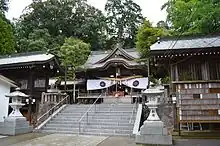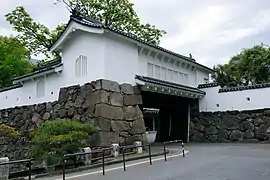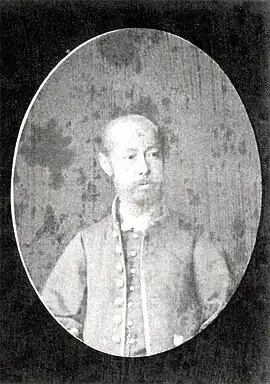
Bungo Province (豊後国, Bungo-no kuni) was a province of Japan in the area of eastern Kyūshū, corresponding to most of modern Ōita Prefecture, except what is now the cities of Nakatsu and Usa.[1] Bungo bordered on Hyūga to the south, Higo and Chikugo to the west, and Chikuzen and Buzen to the north. Its abbreviated form was Hōshū (豊州), although it was also called Nihō (二豊). In terms of the Gokishichidō system, Bungo was one of the provinces of the Saikaidō circuit. Under the Engishiki classification system, Hyūga was ranked as one of the "superior countries" (上国) in terms of importance, and one of the "far countries" (遠国) in terms of distance from the capital.
History
Early history
During the Kofun period, the area of Bungo had three main power centers: the Kunisaki Peninsula, the area around what is now Ōita District and the area around Hita District, each of which was ruled by a kuni no miyatsuko. By the Asuka period, the area had been consolidated into a single province called Toyo Province, also called Toyokuni no Michi no Shiri. After the Taika Reforms and the establishment of the Ritsuryō system in 701, Toyo Province was divided into Bungo and Buzen Provinces. The Bungo no Kuni Fudoki, which was compiled in the first half of the 8th century, is one of only five fudoki in Japan that remains in almost complete form.
It is believed that the kokufu Bungo was located in the Furugō (古国府), literally "old capital," section of the city of Ōita, but as of 2023 no archaeological evidence has been found. Two shrines vie for the title of ichinomiya of Bungo Province: the Yusuhara Hachimangū and the Sasamuta Shrine, both of which are located in the city of Ōita, as is the Bungo Kokubun-ji. Usa Jingū, commonly known as "Usa Hachimangū", is often mistakenly stated to be the ichinomiya of the province, but it is located in former Buzen Province and not Bungo.
In 1185, at the end of the Heian period, after the Heike clan was destroyed in the Genpei War, Minamoto no Yoritomo established the Ōtomo clan as shugo over Bungo Province in order to suppress the pro-Taira clan samurai in Kyushu. The Ōtomo ruled the area from the Kamakura period into the Muromachi period and over the course of many conflicts expanded their control into neighboring provinces. The area saw an influx of western culture and technology with the influx of Portuguese traders in the Sengoku period, together with the introduction of firearms and Christianity. The Funai area became a center of Jesuit activity. Ōtomo Sōrin met personally with Francis Xavier in 1551, and later converted to Christianity. Referred to as the "King of Bungo" in the Jesuit records, Sōrin sent political delegations to Goa in the 1550s, and the Tenshō embassy to Rome in 1582. He also forced his subjects to convert.[2]and ordered the destruction of Buddhist temples and Shinto shrines in his domains.[3]In 1578, he came into conflict with the Shimazu clan to the south and after being defeated in a series of battles turned to Toyotomi Hideyoshi for assistance. In 1587, following Hideyoshi's iconquest of Kyūshū, Sōrin's son, Ōtomo Yoshimune was restored to control over Bungo. Following Hideyoshi's expulsion of foreign missionaries and edicts against the Kirishitan faith, he recanted his baptism and began a vigorous campaign to exterminate Christianity in the province. However, he subsequently was accused of cowardice during the Japanese invasions of Korea (1592–1598) and was dispossessed. Bungo was divided into small holdings.
Edo Period and early modern period
Unlike many of the provinces of Kyūshū, Bungo was not dominated by a single daimyō; rather, it was divided into tenryō territory directly governed by the Tokugawa shogunate and a number small feudal domains.
| Name | Clan | Type | kokudaka |
|---|---|---|---|
| Nakagawa | Tozama | 70,000 koku | |
| Inaba | Tozama | 50,000 koku | |
| Nomi-Matsudaira | Fudai | 32,000 koku | |
| Kinoshita | Tozama | 25,000 koku | |
| Ogyū-Matsudaira | Fudai | 22,200 koku | |
| Mōri | Tozama | 20,000 koku | |
| Kurushima | Tozama | 12,500 koku |
Following the Meiji restoration, each of the feudal domains briefly became prefectures. These were merged on December 25, 1871 to form Ōita Prefecture. [4] Per the early Meiji period Kyudaka kyuryo Torishirabe-chō (旧高旧領取調帳), an official government assessment of the nation's resources, Bungo Province had 1812 villages with a total kokudaka of 466,611 koku. Bungo Province consisted of:
| District | kokudaka | villages | Controlled by |
|---|---|---|---|
| Kunisaki (国東郡) | 81,339 koku | 207 villages | Tenryō, Kitsuki, Nobeoka, Shimabara |
| Hayami (速見郡) | 59,230 koku | 123 villages | Tenryō, Kitsuki, Hiji, Nobeoka, Mori, Nobeoka |
| Ōita (大分郡) | 71,302 koku | 269 villages | Tenryō, Funai, Usuki, Mori, Kumamoto, Nobeoka |
| Amabe (海部郡) | 62,275 koku | 317 villages | Tenryō, Usuki, Saiki, Kumamoto |
| Ōno (大野郡) | 72,685 koku | 460 villages | Oka, Usuki |
| Naoiri (直入郡) | 49,799 koku | 303 villages | Tenryō, Oka, Kumamoto |
| Kuso (玖珠郡) | 30,841 koku | 40 villages | Tenryō, Mori |
| Hita (日田郡) | 33,076 koku | 93 villages | Tenryō, Mori |
Gallery
 Sasamuta Jinja, one of the ichinomiya of the province
Sasamuta Jinja, one of the ichinomiya of the province Bungo Kokubun-ji
Bungo Kokubun-ji Funai Castle
Funai Castle Kinoshita Toshimasa, final daimyō of Hiji Domain
Kinoshita Toshimasa, final daimyō of Hiji Domain
Notes
- ↑ Nussbaum, Louis-Frédéric. (2005). "Bungo" in Japan Encyclopedia, p. 411, p. 411, at Google Books.
- ↑ Palmer, Edwina (2021). Asian Futures, Asian Traditions. Brill Publishers. p. 88. ISBN 978-90-04-21378-4.
- ↑ Mase-Hasegawa, Emi (2008). Christ in Japanese Culture: Theological Themes in Shusaku Endo's Literary Works. Brill Publishers. p. 23. ISBN 978-90-474-3321-7.
- ↑ Nussbaum, "Provinces and prefectures" at p. 780.
References
- Nussbaum, Louis-Frédéric and Käthe Roth. (2005). Japan encyclopedia. Cambridge: Harvard University Press. ISBN 978-0-674-01753-5; OCLC 58053128
- Papinot, Edmond. (1910). Historical and Geographic Dictionary of Japan. Tokyo: Librarie Sansaisha. OCLC 77691250
- (in Japanese) Kōzuke on "Edo 300 HTML"
External links
![]() Media related to Bungo Province at Wikimedia Commons
Media related to Bungo Province at Wikimedia Commons
